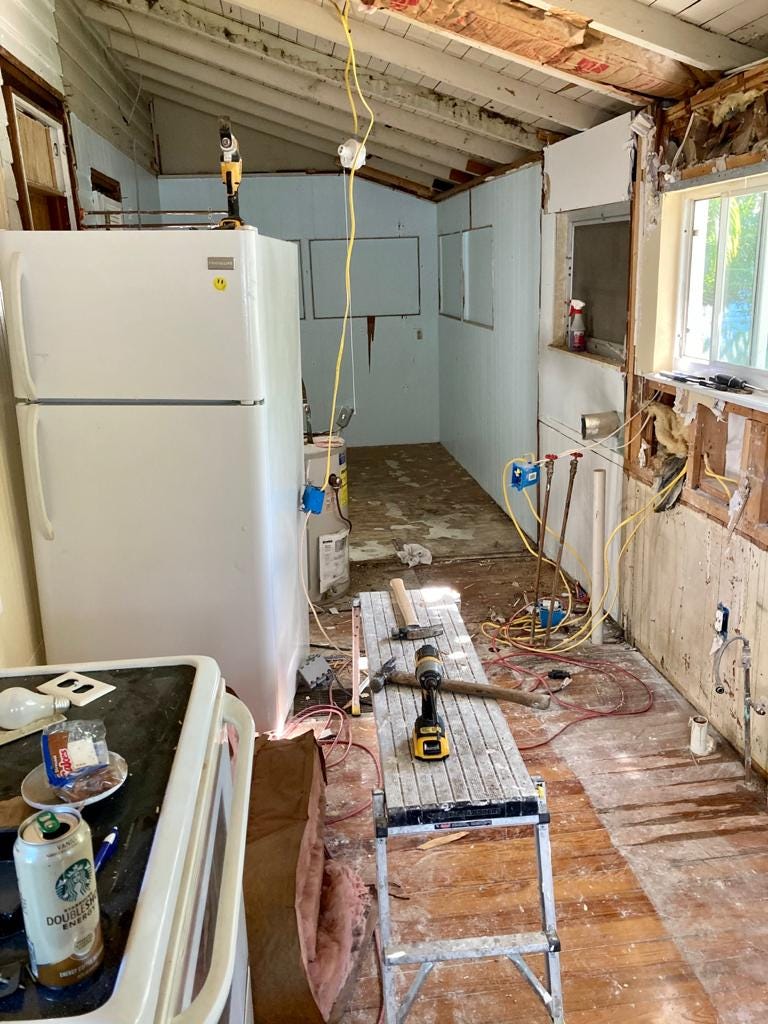Featured in this issue: Jackie’s brand spanking new kitchen and Stanley Tucci’s biceps. Now how do we get Stanley Tucci into Jackie’s kitchen? 😏
If someone shared this newsletter with you, subscribe here:
I’ve talked about my kitchen renovation quite a bit over the last three months. Besides two ovens delayed due to the global appliance shortage caused by the pandemic, the project is finally (blissfully!) complete. I’m so delighted to once again be surrounded by bubbling ferments, too much bread, and many happy smells and tastes!
As some of you know, this spring I am launching a bread club, which is sort of like a CSA but for baked goods. I’ll bake everything in my home kitchen, have a limited product range, and a purposefully small customer base. Ground Floor Farm was a labor of love, but running such a large, sprawling business was not always a boon for my sanity. I’m hoping this new venture will remain small and manageable, allowing me to continue the slower pace I’ve grown to love over the last two years. (P.S. As soon as the website is up and running and Otto’s Bread Club is ready for primetime, you all will be the first to know!)


love,
Jackie
Do you know somebody that likes bread? Share this newsletter with them:
🐄 Farming Vocab: Part 2
More common words you might here to describe agricultural practices. Here’s Part 1.
1️⃣Regenerative farming attempts to reverse aspects of climate change through increasing biodiversity and rebuilding soil health, which can sequester carbon in the ground. Common practices include managed grazing, polyculture, no till, composting, and cover-cropping.
2️⃣Small-scale farming generally refers to operations between 1 and 10 acres, although definitions vary. For reference, the average size of a U.S. farm is 443 acres. A 3️⃣micro farm is on less than one acre, and usually employs intensive techniques like SPIN to grow as much as possible on the small plot.
4️⃣Biodynamic farming is a holistic approach based on the work of Austrian philosopher Rudolph Steiner. The farm is looked at as one whole, integrated, living organism. At its core are techniques that focus on biodiversity and fertility. Biodynamics includes a spiritual element, with regular fertilization rituals based on the moon cycle, and a “recognition of the spirit in nature.”
5️⃣Closed-loop agriculture recycles all nutrients and organic matter (cow poop, dead plants, etc) back into the soil, sequestering carbon. This limits the need for additional inputs like synthetic pesticides and fertilizers.
-Jackie
🇮🇹Stanley Tucci: Searching for Italy | CNN
Have you too fantasized about actor Stanley Tucci, dressed in naught but a snug turtleneck, feeding you slices of pecorino while you lounge together in bed? Whether you have or whether you have but won’t admit it, it’s time to tune into CNN’s latest food travel show, “Stanley Tucci: Searching for Italy.” It’s the network’s first foray into food content since the passing of the beloved Anthony Bourdain (host of “Parts Unknown.”) Tucci’s trip around Italy is far more bourgeois than the punk “Parts Unknown”, but still manages to capture a bit of its predecessor’s spirit. The impeccably polished Tucci, with his heavenly diction and perfect suits (and oh! Those aforementioned turtlenecks!) is a delightful tour guide across his ancestral home. Each episode explores a different region and its foodways. Pizza and lemons in Campania. Pasta and offal in Lazio.
I could spend all day watching Tucci eat bowl after bowl of pasta, but it’s not all about the food porn. The show does an excellent job of weaving in history, culture, and craft into every dish, painting a portrait of Italy, its people, and their passion for food. Did you know that the creation of pizza, originally a fried food, was intimately linked to an outbreak of cholera in Naples? Or that antifascists used pasta as a symbol in their fight against Mussolini (who claimed pasta caused impotence)? (Hat tip Marian and Otto.)
🍖Meatpacking in the Pandemic | Last Week Tonight
John Oliver crams all the macabre realities of meatpacking into this 20 minute segment. The pandemic has made a perilous job even less secure. The segment demonstrates how callous industry leaders are toward the people who work on the lines:
Plant managers at one Tyson factory in Iowa took bets on which workers would contract Covid-19. (They were fired, but that didn’t make the place any safer. 1,500 workers have caught covid-19 and eight have died).
On production lines, laborers are denied bathroom breaks — resulting in some people wearing diapers and a video of one man urinating under the conveyor belt during his shift.
Regulations are so toothless that it’s easier to risk an OSHA violation (that potentially kills someone) than upgrade the numerous safety and health hazards workers face inside a slaughterhouse.
🌾How I Found Empowerment in the History of Black Veganism | Eater
Amirah Mercer worried that taking up a plant-based diet would betray tradition and sully memories of fat pork chops and tangy barbecue ribs. But as she journeyed toward veganism, she learned there’s been a long, radical history of plant-based eating in Black American culture.
She had associated veganism with white hipsters and Goop moms because the wellness industry has often ignored BIPOC vegans. But plants always have been central to diets in West Africa and Central Africa (rice, field peas, okra, hot peppers, and yam), and that diet was disrupted in the Americas by slavery and the influence of European foodways. Now that plant-centric subsistence, which survived in part due to Black religious sects (like Seventh-Day Adventists), is moving back into the mainstream.
Black people are the fastest-growing vegan demographic in the U.S. Black communities — historically neglected by the state in terms of quality of medical care and access to preventative treatment — use food and nutrition as a way to fight against oppression. And Black food activists are influenced by past ideas like the Black Panther Party’s free breakfast program to build “a conscious community by way of nutrition.” Mercer explores the history of plant-based eating among Black people and realizes that as “a Black woman in America, my veganism is, in fact, a homecoming.”
Sourdough Kvass
I first tried bread kvass in a centuries-old restaurant in a village in Lithuania while visiting my friend Saule. Like mead, it’s the sort of drink with a flavor that feels ancient. Nowadays kvass — a sour, fizzy drink with Russian roots — is more commonly made with beets. But I highly recommend making it with bread, which provides sweet and bitter notes similar to a sour beer.
Food scholar Darra Goldstein taught a bread kvass workshop at Florida Ferment Fest’s recent Bread + Butter January. Her recipe called for packaged yeast, but I wanted to try and make it with sourdough starter. This recipe has a noticeable bit of alcohol in it, so probably best not to serve it to the kiddos. Serves 2-3
Ingredients
200-300 grams stale or going stale whole wheat or rye bread (whole grains will give the drink a deeper flavor)
6 cups water
1/2 cup honey
1 tablespoon active sourdough starter (unfed but a mature starter straight from the fridge is fine)
2-3 inches grated ginger, skin on
fine mesh sieve
thin cotton kitchen towel
half-gallon mason jar, or another container that is taller than it is wide
clean, empty bottles for storage (E.g. plastic soda bottles, flip top bottles, growlers, or wine bottles with corks)
step-by-step
Preheat oven to 400°F. Cut bread into 1-inch cubes.
Toast bread on a baking sheet in oven for 20-30 minutes, until very dark. This step brings out the sugars.
In a large bowl, mix together water and sugar. Stir in bread and allow it to sit loosely covered on the counter for the next 24 hours.
The next day, place the kitchen towel over the sieve and the sieve over a bowl. Pour the bread and water mixture into the towel and smoosh and squeeze, allowing as much water as possible to drain out of the sieve and into the bowl. Compost or discard the bread solids (or dehydrate them to make bread crumbs).
Add the bread-flavored water to the half-gallon jar. Stir in the sourdough starter and grated ginger.
Allow to ferment, loosely covered at room temperature, for the next 5-7 days. Stir twice daily to ensure mold or kahm yeast don’t form on the surface. A thickish foam (like the head of a beer) will likely form on the surface during fermentation, which is fine.
After a week, strain the kvass again through the towel-lined sieve, composting or discarding the ginger and sourdough solids.
Pour the kvass into the storage bottles and seal, leaving at least an inch of headspace. For a kvass that is only slightly sparkling, store the bottles in the fridge for 3-4 days, at which point they are ready to enjoy. If you prefer a super fizzy kvass, allow the bottles to carbonate at room temperature for several days before transferring to the fridge.*
*If choosing this method, I HIGHLY recommend that at least one of the storage bottles is made from plastic (like a used soda bottle) as a guide. The bottle will become rock hard once the drink is carbonated (something you cannot gauge with a glass bottle). This way, you don’t have to worry about anything over-carbonating and exploding on your counter.
Looking for another recipe idea? The wonderful artist Mollie Douthit recently recommended Jackie’s peanut butter cup bars in her own newsletter. Check it out here 🤤
Submit an event to sunshineandmicrobes@gmail.com
Cooking Class with Chef Clay Conlay of Buccan | March 2 | $65 | Kai Kai Farm
Cooking Class with Chef Tim Lipman of Coolinary Cafe | March 8 | $65 | Kai Kai Farm
Farm, Forage, & Food Waste Ferments: a month of virtual learning with FL Ferment Fest | March 8-26 | Virtual
Foraged & Infused Sea Salt with Jackie | March 18th at 6 PM | $15 (for charity!) | Zoom
Me want cookie geode! 🍪🍪🍪


Talk to Us
Send in your comments, mailbag questions, recipe mishaps, or cooking tips: sunshineandmicrobes@gmail.com. Also do us a favor and follow us on Facebook and Instagram. Visit our website and cook yourself something nice.
If you enjoyed this email, please share it with others. If someone forwarded this to you, click the button to sign up:
----------------------------------------------------------------------------------------
Sunshine + Microbes team
Jackie Vitale is a cook and kitchen educator based in Stuart, Fla . She is co-founder of the Florida Ferment Fest. Her newsletter explores the intersection of food, culture, environment and community.
Matt Levin is a communications specialist at the ACLU of Texas. He edits Sunshine + Microbes and contributes other scraps to each issue.











